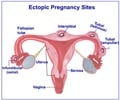Three proteins known as XIAP, BID, and Bcl-2 are responsible in part for the success of progesterone treatments in the prevention of preterm labor

"Dr. Norwitz's research adds to our basic understanding of what triggers labor, how the fetal membranes rupture and the role progesterone plays," said Alan R. Fleischman, MD, medical director of the March of Dimes.
In the United States, more than half a million babies are born preterm each year. Preterm birth, before 37 weeks of pregnancy, is a serious health problem that costs the United States more than $26 billion annually. It is the leading cause of newborn death, and babies who survive often face the risk of lifetime health challenges. Even infants born just a few weeks early have higher rates of hospitalization and illness than full-term infants. The last few weeks of pregnancy are critical to a baby's health because many important organs, including the brain, are not completely developed until then.
Today's award-winning study, "Progesterone Inhibits Basal Apoptosis In Fetal Membranes By Altering Expression Of Both Pro- And Anti-Apoptotic Proteins," is the eighth study by SMFM members to be honored by the March of Dimes for innovative research focused on preventing premature birth. The research was supported in part by a March of Dimes grant. March of Dimes is conducting a national Prematurity Campaign aimed at using research and awareness to reduce the increasing rate of premature birth.
Source-Eurekalert













